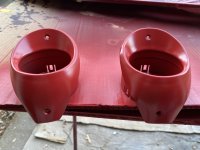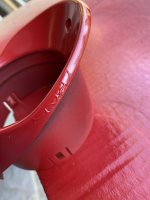These are the AC vent bezels I primed last nice. They looked great this am. I didn’t degrease them because they hadn’t been touched since the red tinted epoxy was applied. I lightly tacked them and sprayed Vaspar base. This wrinkling occurred on both bezels - oddly or perhaps coincidentally it occurred at almost the same orientation on both pieces, kind of the 2:00 - 3:00 position if you are standing in front of the parts. The other pieces that I painted has no such problem. (Other than dropping my freshly painted glove box door  - didn’t do as much damage as one would think but edge still needs to be touched up).
- didn’t do as much damage as one would think but edge still needs to be touched up).
The new plastic bezels were sanded with 400, hit with Bulldog adhesion promoter and painted with Valspar epoxy primer last night. The wrinkling definitely happened within minutes after the bases was applied. I think it occurred after the second coat of base.
The new plastic bezels were sanded with 400, hit with Bulldog adhesion promoter and painted with Valspar epoxy primer last night. The wrinkling definitely happened within minutes after the bases was applied. I think it occurred after the second coat of base.


